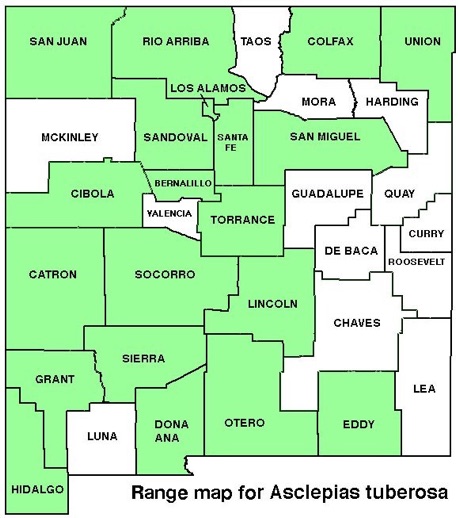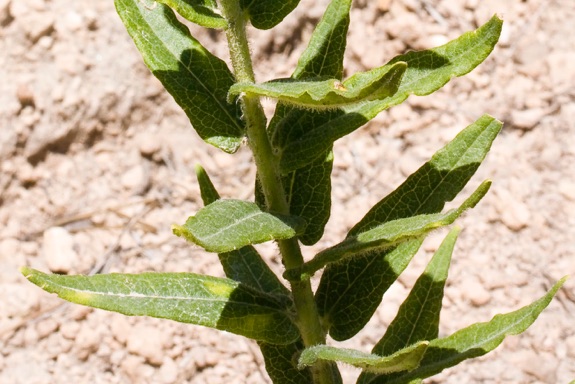WILDFLOWERS OF NEW MEXICO

The erect, hairy, 1 1/2–3-foot tall stems have dense clusters of orange to yellow flowers and many hairy leaves. Note this species is the only milkweed in NM that exudes clear, instead of milky, sap. This popular landscape plant attracts as many as 70 species of butterflies, moths, and other insects, as well as hummingbirds.
FLOWERS: May–September. Yellow to orange flowers in loose, rounded clusters (umbels) 2–5-inches across (5–12.7 cm); flowers have 5 petal-like lobes that bend backwards with the tips spreading, 5 erect hoods with needle-like horns arching toward the central column. Fruit pods are slender, hairy, to 6 inches long (15 cm), and open to release flat seeds attached to fluffy hairs.
LEAVES: Alternate, irregularly spaced, crowded, on short stems (petioles). Blades narrow, lance-shaped, 1–4-inches long (2.5–10 cm) to 1 1/4-inches wide (3 cm), margins entire (no teeth), surfaces variably hairy.
HABITAT: Moist sandy, gravelly, loam soils; pinion-juniper woodlands, ponderosa forests.
ELEVATION: 3,600–8,200 feet.
RANGE: Widespread CA to Great Lakes and Atlantic Ocean; eastern Canada.
SIMILAR SPECIES: A. tuberosa varies in foliage and flower color, but is the only species of Asclepias in NM with showy yellow to orange flowers. The look-alike Mexican species A. curassavica, often seen in landscapes, has smooth stems, milky sap, and is not freeze tolerant.
NOTES: Numerous butterfly, beetle, bee and other insect species feed on nectar from all milkweed species. Monarch and Queen butterflies lay their eggs and the larva feed on A. tuberosa, but large bees and beetles pollinate it. Monarch Butterfly larva concentrate the cardiac glycosides in the leaves to make the adults poisonous to birds.
NM COUNTIES: Scattered statewide in low- to mid-elevation, moist habitats: Bernalillo, Catron, Cibola, Colfax, Dona Ana, Eddy, Grant, Hidalgo, Lincoln, Los Alamos, Otero, Rio Arriba, Santa Fe, San Juan, San Miguel, Sandoval, Sierra, Socorro, Torrance, Union.

BUTTERFLY MILKWEED
ASCLEPIAS TUBEROSA
Dogbane Family, Apocynaceae (formerly Milkweed Family, Asclepiadaceae)
Perennial herb
THE CONTENTS OF THIS WEBSITE ARE COPYRIGHTED AND CANNOT BE USED
WITHOUT PERMISSION OF GEORGE OXFORD MILLER




-
1.Petal-like lobes (upper arrow).
-
2. Horns inside hoods (middle arrow).
-
3. Hood of flower (lower arrow).




Stems and leaves are hairy.
EMAIL ME